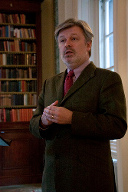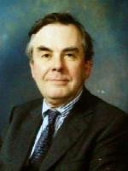Patrons of the Latin Mass Society
Since 2012 the Latin Mass Society has been supported by a number of distinguished lay Patrons, who have kindly agreed to be associated with the Society, and in many cases are actively involved in our work.

John Smeaton
John Smeaton was Chief Executive of the Society for the Protection of Unborn Children (SPUC) from 1996 to 2021, and is the foremost pro-life campaigner in Britain. In 2013, he received the Cardinal John J. O’Connor Pro-Life Award from Legatus, an international organization of Catholic business leaders; and in 2015, he received the first Fr Paul Marx Award from Human Life International. He now leads Voice of the Family, which was founded in 2014 to defend Catholic teaching on the family, and publishes Calx Mariae magazine.

Professor Thomas Pink
Professor Pink is a Philosopher based at King’s College London. He converted to Catholicism as a young man and has recently made important contributions to debates on religious freedom and the relationship between Church and State, as well as being a rare scholar of late Scholastism. He is often to be seen at Society events in London and has contributed to a Conference organised by the LMS and the Iota Unum series of talks. The first of these talks can be heard on Podbean here.
More about his academic work can be seen on his page on King’s College website here. He described his faith journey in an article in the Catholic Herald here.

Sir James MacMillan CBE
Sir James is a composer who has made a considerable contribution to liturgical and religious music. His works include the setting for the Beatification Mass of John Henry Newman celebrated by Pope Benedict XVI in 2010. He is well known for his tireless campaigning for excellence in Church music, insisting on the importance of Gregorian Chant. He is today the best known and most distinguished Catholic musician in the UK. He has spoken to a meeting of the Gregorian Chant Network, which is affiliated to the Latin Mass Society. He was given a CBE and (Commander of the Order of the British Empire) in 2004, and made a Knight Bachelor in 2015.
See his Wikipedia page here.

Charles Moore, Lord Moore of Etchingham
Lord Moore is a former editor of The Daily Telegraph, The Spectator and The Sunday Telegraph, and the authorised biographer of Lady Thatcher. He is the most senior and distinguished defender of the Church’s teachings in British journalism today.
He converted to Catholicism in 1992. He was ennobled in 2020.
See his Wikipedia page here.

Sir Edward Leigh, Picture by
Richard Townshend,
CC BY-SA 3.0, Link
The Rt Hon Sir Edward Leigh
Sir Edward Leigh has sat as a Member of Parliament for Gainsborough since 1983. He is among the most respected Catholic members of Parliament, and has served as a Secretary of State and held many important roles in Parliamentary committees. He was knighted in 2013, is an Officer of the Légion d’honneur of France, and a Commander of the Order of the Star of Italy.

The Rt Hon Lord (Brian) Gill KSG
Lord Gill is a former Lord President of the Court of Session, Scotland’s most senior judge. He retired from this role in 2015, and sits on the UK’s Supreme Court’s Supplementary Panel of Judges.
He was made a Knight of the Order of St Gregory (KSG), a papal knighthood, in 2012. He is a longstanding supporter the Traditional Latin Mass. He currently lives in London and is often to be seen at the Society’s London events.

Sir Adrian FitzGerald
Sir Adrian is the Green Knight of Kerry. He has been a President of the Irish Association of the Knights of Malta, a mayor of the Royal Borough of Kensington and Chelsea, and a Chairman of the Governors of the Cardinal Vaughan Memorial School.
He divides his time between London and Waterford, Ireland.
Deceased Patrons
Prince Rupert Löwenstein (or Loewenstein), 1933-2014
Prince Rupert was a descendent of the Royal House of Bavaria, and for many years the President of the Latin Mass Society. He became its first Patron in 2012.
He is most famous as banker to the Rolling Stones, but was also a generous philanthropist, a President of the British Association of the Knights of Malta, and the father of two priests: one a Dominican, the other a member of the Fraternity of St Peter.
See his Wikipedia page here. He wrote an autobiography, A Prince Among Stones.
Colin Mawby KSG, 1936-2019
Colin Mawby was Master of Music at Westminster Cathedral from 1961 to 1975, an important composer of choral music, including much liturgical music, a strong defender of the Church’s musical traditions and a promoter of Gregorian Chant.
He took part as organist and tutor in several Chant Training Weekends organised by the Gregorian Chant Network, which is affiliated to the LMS.
It was typical of his generosity with his time that he volunteered to compose a setting for the Song of the English Zouaves which we wished to sing on the LMS Walking Pilgrimage to Walsingham. The song and its setting is found in the LMS publication Vademecum Peregrini: A Pilgrim’s Handbook.
He was made a Knight of the Order of St Gregory, a Papal Knighthood, in 2006.
See his obituary in the Church Times.
